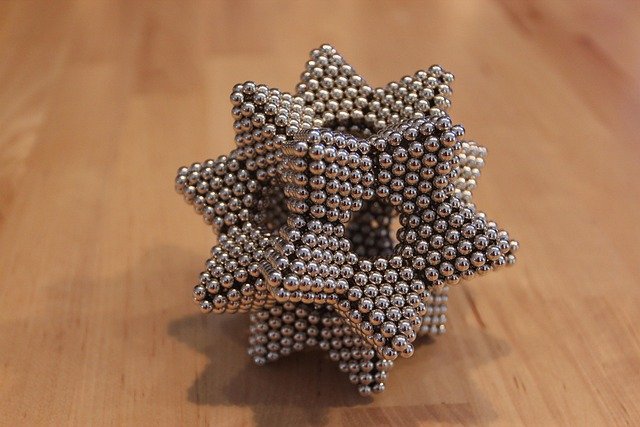Have you ever held a magnet near a paper clip and watched it jump without even touching? Or pushed two magnets together only to feel them resist like there’s an invisible wall between them? That’s the magic of magnets.
Magnets can pull, push, and even make things move without any strings, motors, or batteries. They can stick to your fridge, guide ships across oceans, and power giant machines in factories. You can’t see the force they create, but you can see what it does — and that’s what makes them so fascinating.
In this guide, we’ll explore what magnets are, how they work, and most importantly, how you can play and experiment with them at home. No complicated words, no boring lessons — just clear, simple explanations and fun, hands-on science you can try right away.
What Magnets Are and Why They’re Special
A magnet is an object that can pull certain metals toward it without even touching them. If you’ve ever held a magnet close to a paper clip and watched the clip jump, you’ve seen this invisible power in action. It almost feels like magic — but it’s science.
Not all metals are attracted to magnets. The most common ones that are magnetic include iron, nickel, and cobalt. If something is made from these metals, a magnet will usually be able to pull it in. Other metals, like gold, silver, or aluminum, won’t respond the same way.
The Invisible Magnetic Field
Magnets work because they create something called a magnetic field — an invisible area around them where their pulling or pushing force can be felt. Imagine an invisible bubble surrounding the magnet. Inside this bubble, the magnet can grab onto things or push them away, even if there’s air, water, or a piece of paper in the way.
You can actually see the shape of a magnetic field using a simple experiment:
- Place a magnet under a sheet of paper.
- Sprinkle iron filings (tiny pieces of iron) on top.
- Gently tap the paper.
The filings will arrange themselves in curved patterns, showing the invisible “lines” of the magnetic field. These lines aren’t real objects — they’re just a way for your eyes to see how the force spreads out from the magnet.
Every Magnet Has Two Poles
Magnets have two special ends, called poles — a north pole and a south pole.
They follow a simple rule:
- Opposite poles attract — north and south pull toward each other.
- Like poles repel — north pushes away from north, and south pushes away from south.
If you hold two magnets so that a north pole faces a south pole, they’ll snap together with a satisfying click. But if you turn one around so both north poles face each other, you’ll feel them push apart, as if an invisible wall is between them.
This push and pull happens because of the way the magnetic fields of each magnet interact. Opposites fit together like puzzle pieces, while likes push away to keep their own space.
Magnets All Around Us

Even if you can’t see them, magnets are hiding everywhere in your daily life:
- The seal in your fridge door has a hidden magnet to keep it shut tight.
- Headphones and speakers use magnets to turn electrical signals into sound waves.
- A compass has a tiny magnetic needle that always points toward Earth’s north pole.
- High-speed maglev trains float above the tracks using super-strong magnets, letting them travel incredibly fast without touching the rails.
Without magnets, much of our modern world — from navigation to electronics — simply wouldn’t work.
Try This: The Magnet Finder Game
You can find magnets in action around your home:
- Grab a small magnet.
- Walk around and test it on different objects — spoons, scissors, coins, door handles, toys.
- Sort your findings into “magnetic” and “non-magnetic” piles.
You’ll quickly notice that not all metals are magnetic. For example, most coins don’t stick to magnets because they’re not made from iron, nickel, or cobalt.
Why Magnets Work – The Science Made Simple
Magnets work because of the movement of tiny particles inside them called electrons. Electrons are part of atoms — the tiny building blocks of everything around us. They have a property called an electric charge, and when they spin and move in a certain way, they create a magnetic field.
In most materials, the magnetic effects of electrons cancel each other out because they’re pointing in random directions. But in magnetic materials like iron, nickel, and cobalt, many of the electrons are lined up so their magnetic fields all point the same way. This alignment turns the whole object into a magnet.
Permanent and Temporary Magnets
- Permanent magnets keep their magnetic field all the time, like the fridge magnets you use to hold up drawings.
- Temporary magnets become magnetic only when they’re near a strong magnet or when an electric current passes through them. For example, an iron nail can become magnetic if you rub it with a magnet — but it will lose its magnetism after a while.
This ability to turn magnetism on and off is used in many technologies, like in electric motors and hard drives.
Earth – The Biggest Magnet Around

Did you know the Earth itself is a giant magnet? Deep inside the Earth is a core made mostly of molten (melted) iron and nickel. The movement of this liquid metal creates a huge magnetic field that surrounds our planet.
This Earth’s magnetic field:
- Protects us from harmful solar radiation by deflecting charged particles from the Sun.
- Makes compasses work — the needle aligns with Earth’s magnetic field, pointing toward the magnetic north.
- Even guides some animals, like sea turtles and birds, during migration.
Magnetic North Isn’t Always the Same
The “north” that a compass points to isn’t exactly the same as the geographic North Pole. It points to the magnetic north pole, which slowly moves over time due to changes in the flow of molten metal inside Earth.
Fun fact: The magnetic poles have even switched places in Earth’s history, with north becoming south and south becoming north. This “pole reversal” happens every few hundred thousand years.
Try It at Home – Fun Magnet Experiments
Here are a few safe and easy ways to explore magnetism yourself.
1. Make a Temporary Magnet
- Take an iron nail and a strong magnet.
- Stroke the magnet along the nail several times in the same direction.
- Test the nail by picking up paper clips — it should now act like a magnet.
2. Compass in a Bowl
- Rub a needle with a magnet to magnetize it.
- Place the needle on a small piece of cork or foam.
- Float it in a bowl of water — it will turn and point north-south, just like a compass.
3. Magnetic Field Patterns
- Place a bar magnet on a table.
- Cover it with a sheet of paper.
- Sprinkle iron filings gently on the paper.
- Tap the paper lightly to see the curved lines of the magnetic field appear.
Types of Magnets – Not All Are the Same

Magnets may share the same magical ability to pull and push, but they’re not all built alike. Understanding the different types helps you see why some magnets are strong enough to lift cars, while others are perfect for holding up a photo on your fridge.
1. Permanent Magnets – Always “On”
A permanent magnet is always magnetic. It has a magnetic field that never turns off, unless it’s damaged or heated to a very high temperature. These magnets are made from special materials like neodymium (one of the strongest magnets in the world), samarium cobalt, or ferrite (often used in fridge magnets).
- Where you’ll find them: fridge doors, bicycle dynamos, electric guitar pickups, toys, and speakers.
- Why they’re amazing: they keep their strength for years without any electricity or charging.
Fun fact: The magnets in some headphones are smaller than a pea but strong enough to move the speaker cone and create sound waves you can hear.
2. Temporary Magnets – Borrowed Power
A temporary magnet is a material that becomes magnetic only when it’s near a strong magnetic field. Once that field is removed, it loses its magnetism.
- Example: an iron nail that becomes magnetic when rubbed with a permanent magnet.
- Where you’ll find them: in scrapyards, giant temporary magnets in cranes lift heavy car bodies, then drop them by switching off the magnetic field.
These magnets are useful when you want strong attraction but also the ability to “let go” instantly.
3. Electromagnets – Magnets You Can Switch On and Off
An electromagnet is created by running an electric current through a coil of wire wrapped around a piece of iron. When electricity flows, the iron becomes magnetic. Switch off the current, and it stops being a magnet.
- Where you’ll find them: doorbells, MRI machines in hospitals, loudspeakers, washing machines, and train brakes.
- Why they’re powerful: you can control their strength by changing the amount of electricity, and they can be made far stronger than most permanent magnets.
Fun fact: The largest electromagnets in the world can lift hundreds of tonnes — enough to raise a whole train carriage.
Magnets in Everyday Life – The Hidden Helpers

Magnets are quietly working behind the scenes in many things you use daily:
- Transport: Maglev trains “float” above tracks using strong magnets to remove friction, allowing smooth rides at speeds of more than 300 km/h.
- Electronics: Computers and hard drives store data magnetically, and your phone’s speaker uses a magnet to create sound from electrical signals.
- Medicine: MRI (Magnetic Resonance Imaging) scanners use extremely strong magnets to take detailed pictures inside your body without surgery.
- Home: From the click of your fridge door closing to the magnetic clasp on a handbag, magnets keep things shut without locks or latches.
Magnets make our lives easier, safer, and more fun — even if we don’t notice them.
More Hands-On Magnet Challenges – Learn by Doing
You can discover a lot about magnets just by playing with them. Here are three fun challenges to try:
1. Magnetic Maze Game
- Draw a maze on cardboard.
- Place a paper clip at the starting point.
- Use a magnet underneath the board to guide the paper clip through the maze without touching it.
This teaches you that magnetic force can pass through materials like cardboard and plastic.
2. Floating Magnet Trick
- Place a pencil upright through the hole of several ring-shaped magnets.
- Make sure the same poles face each other.
- Watch as the top magnet floats above the lower one because of repulsion.
This is a simple way to see how “like poles” push away from each other.
3. Magnet Fishing
- Tie a magnet to a piece of string.
- Drop it into a box filled with rice or sand where you’ve hidden small metal objects (like screws or washers).
- “Fish” them out using only your magnet.
This shows how magnets can find objects even when they’re hidden from view.
The Science of Magnetic Strength
Not all magnets are equally strong. Some can barely hold up a sheet of paper, while others can lift entire cars. The strength of a magnet depends on:
- The material it’s made from — neodymium magnets are much stronger than ferrite magnets of the same size.
- Its size — bigger magnets generally have more pulling power because they have more magnetic material.
- Distance from the object — a magnet’s force gets weaker very quickly the farther away you move it. Even a strong magnet won’t work if it’s too far from the object.
- Temperature — heating a magnet can weaken or destroy its magnetism because it disrupts the alignment of electrons inside it.
Making Magnets Stronger
You can sometimes increase a magnet’s strength by:
- Rubbing it in one direction along another strong magnet to align more of its atoms.
- Cooling it (in some cases) — lower temperatures help keep the electrons more stable.
- Combining magnets — stacking them together makes their magnetic fields add up.
Making Magnets Weaker
Magnets can lose strength if they’re:
- Dropped or hit hard (this shakes the alignment of their atoms).
- Exposed to high heat.
- Placed near another strong, opposite magnetic field.
This is why you should be careful with magnets if you want them to last.
How Debsie Helps Kids Explore Magnetism

At Debsie, we know that learning science isn’t just about reading facts in a book — it’s about experiencing it. Magnetism is the perfect topic to make science come alive for kids, because it’s something they can see, feel, and experiment with right in front of them. Our approach turns that “invisible magic” into real understanding that sticks.
1. Turning Curiosity Into Hands-On Discovery
Kids naturally want to touch, test, and see what happens — and magnetism is perfect for that. In our classes, children don’t just hear “magnets attract iron.” They test it by:
- Picking up paper clips and counting how many a single magnet can hold.
- Guiding a paper clip through a maze using only magnetic force under the board.
- Making a floating magnet trick to see repulsion in action.
- Creating their own temporary magnet by rubbing a nail with a permanent magnet.
These activities let kids feel the push and pull for themselves. Science isn’t just in their heads — it’s in their hands.
2. Showing the “Why” Behind the “Wow”
It’s easy to impress kids with a cool magnet trick. But at Debsie, we go deeper. Our teachers explain why magnets behave the way they do, using clear, simple language kids can follow. For example:
- Why two magnets push away even when you try to force them together.
- Why magnets stick to some metals but not others.
- How an electromagnet can be switched on and off like a light bulb.
We turn “That’s cool!” into “I understand how that works!” — giving kids the confidence to explore more.
3. Connecting Magnetism to Real Life
Kids remember more when they see how science connects to their everyday world. We show them that magnets aren’t just in toys or fridge doors — they’re in:
- Speakers and headphones (turning electrical signals into sound).
- Trains (helping maglev trains float at high speeds).
- Medical machines (like MRIs that take pictures of the inside of your body).
- Navigation tools (like compasses that help travelers find their way).
Once kids see magnets at work in technology, transport, and medicine, they understand that science is useful, not just something for tests.
4. Learning Across Subjects
Debsie has expert partner teachers in physics, maths, biology, chemistry, geography, and more, so magnetism becomes part of a bigger story. A physics lesson on magnetic poles connects to geography when learning about Earth’s magnetic field, and links to history when discussing ancient navigation. This cross-subject approach helps kids build a complete, connected understanding of the world.
5. Building Skills Beyond Science
Our magnetism lessons also help kids develop:
- Critical thinking — predicting what will happen before they try an experiment.
- Problem-solving — figuring out how to move a paper clip maze faster or make a stronger electromagnet.
- Patience and focus — repeating experiments to get consistent results.
These are life skills they’ll use long after the lesson ends. is part of so many areas of life, they become more confident in exploring new ideas.
Magnets in the Future – Shaping Tomorrow’s World
Magnets may seem simple — just a fridge clip or a toy — but they are quietly driving some of the biggest innovations in science and technology. As our world moves toward faster travel, cleaner energy, and smarter machines, magnetism is right at the heart of it all.
Magnetic Transportation – Floating Into the Future
Today’s maglev trains glide above tracks at incredible speeds because magnets lift them up and push them forward. There’s no friction from wheels, so the ride is smooth and lightning-fast. In Japan, maglev trains already reach speeds over 600 km/h, and scientists are working on versions that could connect distant cities in a fraction of today’s travel time.
One day, you might be able to hop on a magnet-powered train in one city and arrive hundreds of kilometres away before you’ve even finished your snack.
Magnets for Clean Energy – Power Without Pollution
Magnets are essential in wind turbines and hydroelectric generators, where they help turn moving air or water into electricity. Without magnets, renewable energy wouldn’t work. Researchers are finding new ways to make these magnets lighter, cheaper, and more powerful, so more people around the world can enjoy clean power without harming the environment.
Imagine a future where every school, home, and even car runs on energy made possible by magnets — that’s the path we’re on.
Medicine – Healing With Magnetic Precision
Magnets aren’t just for machines — they’re helping doctors heal people in incredible ways. Strong MRI machines use magnets to create detailed pictures of what’s happening inside your body, helping doctors find problems without surgery.
In the future, tiny magnet-controlled robots could travel inside the human body, delivering medicine right where it’s needed or repairing tissues without a single cut.
Space Exploration – Magnets Beyond Earth
Magnets could one day help astronauts travel safely through space by protecting them from harmful cosmic rays. They may also be used to store energy for long missions or even help create artificial gravity for space stations. Magnets might just be the tool that helps humans travel to Mars and beyond.
Final Thoughts – Learning Magnets the Debsie Way
Magnets are one of nature’s best ways to spark curiosity. They’re simple to experiment with, but the science behind them connects to physics, geography, engineering, and even space exploration.
At Debsie, we believe that when a child can see and feel a science concept, they truly understand it. That’s why our magnetism lessons are packed with hands-on activities — from making compasses to building electromagnets — so kids don’t just learn the facts, they experience the wonder.
Our expert teachers weave magnetism into a bigger picture, showing students how it powers the world they live in and the world they will one day help shape.
If your child is curious about the invisible forces that move our world, let Debsie guide them. With fun, interactive lessons across all subjects, we make learning something they look forward to — and remember forever.
You can start today with a free trial class and see the excitement for yourself.
👉 Sign up here to let your child’s magnetic learning journey begin.
Read next:
